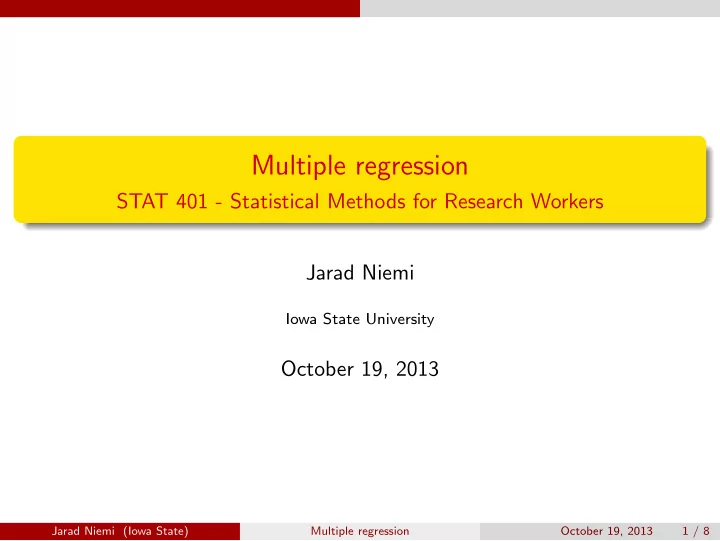

Multiple regression STAT 401 - Statistical Methods for Research Workers Jarad Niemi Iowa State University October 19, 2013 Jarad Niemi (Iowa State) Multiple regression October 19, 2013 1 / 8
Multiple regression model Multiple regression Recall the simple linear regression model is ind ∼ N ( β 0 + β 1 X i , σ 2 ) Y i The multiple regression model is ind ∼ N ( β 0 + β 1 X i , 1 + · · · + β p X i , p , σ 2 ) Y i where Y i is the response for observation i and X i , p is the p th explanatory variable for observation i . Jarad Niemi (Iowa State) Multiple regression October 19, 2013 2 / 8
Multiple regression model Interpretation Interpretation Model: ind ∼ N ( β 0 + β 1 X i , 1 + · · · + β p X i , p , σ 2 ) Y i The interpretation is β 0 is the expected value of the response Y i when all explanatory variables are zero. β j , j � = 0 is the expected increase in Y i for a one-unit increase in X i , j when all other explanatory variables are held constant. R 2 is the proportion of the variance in the response explained by the model Jarad Niemi (Iowa State) Multiple regression October 19, 2013 3 / 8
Multiple regression model Example Longnose Dace Abundance From http://udel.edu/~mcdonald/statmultreg.html : I extracted some data from the Maryland Biological Stream Survey. ... The dependent variable is the number of Longnose Dace (Rhinichthys cataractae) per 75-meter section of [a] stream. The independent variables are the area (in acres) drained by the stream; the dissolved oxygen (in mg/liter); the maximum depth (in cm) of the 75-meter segment of stream; nitrate concentration (mg/liter); sulfate concentration (mg/liter); and the water temperature on the sampling date (in degrees C). Let’s focus on the following model ind ∼ N ( β 0 + β 1 X i , 1 + β 2 X i , 2 , σ 2 ) Y i where Y i : count of Longnose Dace in stream i X i , 1 : maximum depth (in cm) of stream i X i , 2 : nitrate concentration (mg/liter) of stream i Jarad Niemi (Iowa State) Multiple regression October 19, 2013 4 / 8
Multiple regression model Example Exploratory ● ● ● ● 200 200 ● ● 150 150 count count ● ● 100 100 ● ● ● ● ● ● ● ● ● ● ● ● ● ● ● ● ● ● ● ● ● ● 50 ● 50 ● ● ● ● ● ● ● ● ● ● ● ● ● ● ● ● ● ● ● ● ● ● ● ● ● ● ● ● ● ● ● ● ● ● ● ● ● ● ● ● ● ● ● ● ● ● ● ● ● ● ● ● ● ● ● ● ● ● ● ● ● ● ● ● ● ● ● ● ● ● ● ● ● ● ● ● ● ● ● ● ● ● ● ● ● ● ● ● ● ● ● ● ● ● ● ● ● ● ● ● ● ● ● 0 0 0 2 4 6 8 40 60 80 120 160 no3 maxdepth Jarad Niemi (Iowa State) Multiple regression October 19, 2013 5 / 8
Multiple regression model SAS code and output DATA dace; INFILE ’Longnose Dace.csv’ DSD FIRSTOBS=2; INPUT stream $ count acreage do2 maxdepth no3 so4 temp; PROC REG DATA=dace; MODEL count = maxdepth no3; RUN; The REG Procedure Model: MODEL1 Dependent Variable: count Number of Observations Read 67 Number of Observations Used 67 Analysis of Variance Sum of Mean Source DF Squares Square F Value Pr > F Model 2 28930 14465 7.68 0.0010 Error 64 120503 1882.85220 Corrected Total 66 149432 Root MSE 43.39184 R-Square 0.1936 Dependent Mean 39.10448 Adj R-Sq 0.1684 Coeff Var 110.96388 Parameter Estimates Parameter Standard Variable DF Estimate Error t Value Pr > |t| Intercept 1 -17.55503 15.95865 -1.10 0.2754 maxdepth 1 0.48106 0.18111 2.66 0.0100 no3 1 8.28473 2.95659 2.80 0.0067 Jarad Niemi (Iowa State) Multiple regression October 19, 2013 6 / 8
Multiple regression model SAS code and output Interpretation Intercept ( β 0 ): The expected count of Longnose Dace when maximum depth and nitrate concentration are both zero is -18. Coefficient for maxdepth ( β 1 ): Holding nitrate concentration constant, each cm increase in maximum depth is associated with an additional 0.48 Longnose Dace counted on average. Coefficient for no3 ( β 2 ): Holding maximum depth constant, each mg/liter increase in nitrate concentration is associated with an addition 8.3 Longnose Dace counted on average. Coefficient of determination: The model explains 19% of the variability in the count of Longnose Dace. Jarad Niemi (Iowa State) Multiple regression October 19, 2013 7 / 8
Multiple regression model SAS code and output Future Possible explanatory variables: Additional explanatory variables Higher order terms Dummy/indicator variables for categorical variables Interactions Jarad Niemi (Iowa State) Multiple regression October 19, 2013 8 / 8
Recommend
More recommend